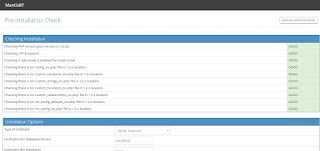Install MantisBT(Bug Tracker) on linux | In this article
we learn what is MantisBT and how to install MantisBT(Bug Tracker) on centos/RHEL/Oracle(6/7) linux server.
What is MantisBT(Bug Tracker)?
MantisBT(Bug Tracker) is
free and open source web based bug tracking system which is written in php.Its
web interface is very simple to customize to trace the software bug.
Installation LAMP stack
Before
installing and setup MantisBT we need to install LAMP stack. To install LAMP
stack we execute the below command.
[root@localhost
~]# yum install httpd mariadb mariadb-server php php-common php-mysql php-gd php-xml
php-mbstring php-mcrypt php-xmlrpc unzip wget –y
After
installing the all required packages we start the service . To start the
service we execute the below command.
[root@localhost
~]# systemctl start httpd
[root@localhost
~]# systemctl start mariadb
Configuration of Mariadb database for MantisBT on centos server
After installing
the database we need to secure the database using the below command.
#mysql_secure_installation
NOTE:
RUNNING ALL PARTS OF THIS SCRIPT IS RECOMMENDED FOR ALL MariaDB
SERVERS IN PRODUCTION USE! PLEASE READ EACH STEP CAREFULLY!
In order
to log into MariaDB to secure it, we'll need the current
password
for the root user. If you've just
installed MariaDB, and
you
haven't set the root password yet, the password will be blank,
so you
should just press enter here.
Enter
current password for root (enter for none):
OK,
successfully used password, moving on...
Setting
the root password ensures that nobody can log into the MariaDB
root
user without the proper authorisation.
Set root
password? [Y/n] y
New
password:
Re-enter
new password:
Password
updated successfully!
Reloading
privilege tables..
... Success!
By
default, a MariaDB installation has an anonymous user, allowing anyone
to log
into MariaDB without having to have a user account created for
them. This is intended only for testing, and to
make the installation
go a bit
smoother. You should remove them before
moving into a
production
environment.
Remove
anonymous users? [Y/n] y
... Success!
Normally,
root should only be allowed to connect from 'localhost'. This
ensures
that someone cannot guess at the root password from the network.
Disallow
root login remotely? [Y/n] y
... Success!
By
default, MariaDB comes with a database named 'test' that anyone can
access. This is also intended only for testing, and
should be removed
before
moving into a production environment.
Remove
test database and access to it? [Y/n] y
- Dropping test database...
... Success!
- Removing privileges on test database...
... Success!
Reloading
the privilege tables will ensure that all changes made so far
will
take effect immediately.
Reload
privilege tables now? [Y/n] y
... Success!
Cleaning
up...
All
done! If you've completed all of the
above steps, your MariaDB
installation
should now be secure.
Thanks
for using MariaDB!
After that restart the service using
the below command.
#systemctl restart
mariadb
Now create the MantisBT database and
user using the below steps.
# mysql -u root -p
MariaDB [(none)]>
create database mantisdb;
MariaDB [(none)]>
CREATE USER mantis@localhost IDENTIFIED BY "mantis";
MariaDB [(none)]> GRANT
ALL ON mantisdb.* TO mantis@localhost;
MariaDB [(none)]>
FLUSH PRIVILEGES;
MariaDB [(none)]>
exit
Install MantisBT on centos server
Now we
download the latest version of the MantisBT from their official website.To
download the MantisBT package we need to execute the below command.
Once the download is completed, we
extract the downloaded archive using the below command.
#unzip
mantisbt-2.5.1.zip
Now create a directory called mantis
under “/var/ww/html” and move the extracted file to this directory and change
the ownership of the directory using the below steps.
#Mkdir –p /var/ww/html/mantis
#mv mantisbt-2.5.1
/var/www/html/mantis
#chown -R
apache:apache /var/www/html/mantis
Configure virtual host for mantisBT
We need to
configure apache virtual host for mantis .To do this create a file called
mantis.conf under the “/etc/httpd/conf.d” and add the below lines.
<VirtualHost *:80>
ServerAdmin admin@example.net
ServerName example.net
DocumentRoot /var/www/html/mantis
<Directory />
Options FollowSymLinks
AllowOverride All
</Directory>
<Directory /var/www/html/mantis>
Options FollowSymLinks MultiViews
AllowOverride All
Order allow,deny
Allow from All
</Directory>
TransferLog /var/log/httpd/mantis_access.log
ErrorLog /var/log/httpd/mantis_error.log
</VirtualHost>
Now save and quit the file and restart the apache service.
ServerAdmin admin@example.net
ServerName example.net
DocumentRoot /var/www/html/mantis
<Directory />
Options FollowSymLinks
AllowOverride All
</Directory>
<Directory /var/www/html/mantis>
Options FollowSymLinks MultiViews
AllowOverride All
Order allow,deny
Allow from All
</Directory>
TransferLog /var/log/httpd/mantis_access.log
ErrorLog /var/log/httpd/mantis_error.log
</VirtualHost>
Now save and quit the file and restart the apache service.
we need to allow http and https
service in the firewall. To do this we need to execute the below command.
[root@localhost
~]#firewall-cmd –permanent –add-service=http
[root@localhost ~]#firewall-cmd –reload
To finish the final installation we
need open the browser and type the url as below.
to fill up all database related info
the press upgrade and install and will get the next below screen.
 |
| final step to install MantisBT on CentOS 7 |
Then press continue button and you
will get the login screen . type username as administrator and password as
root.
That’s all . if this article is helpful about to know how to install MantisBT on CentOS/RHEL/Oracle 7 please share it.



0 comments:
Post a Comment